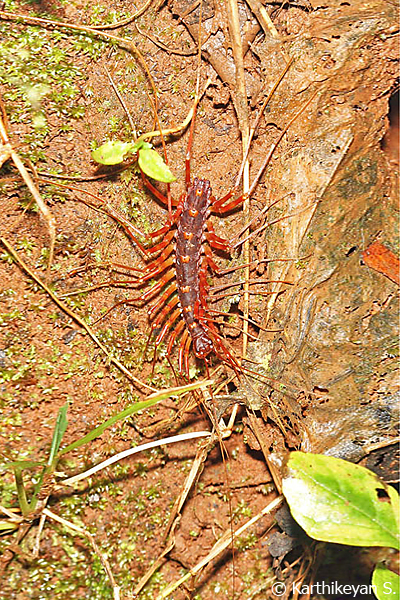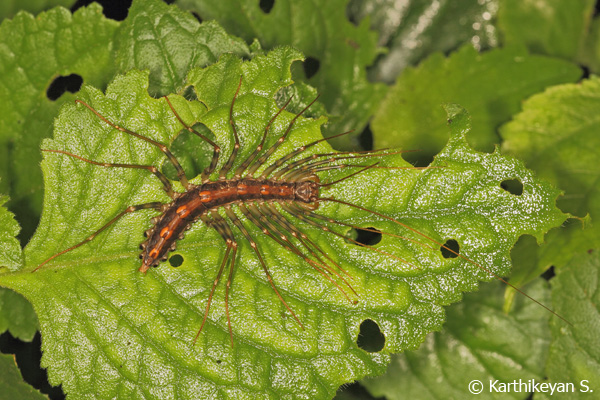Moving at a great speed has its own disadvantages; especially in the dark and more so, if you have one too many legs! There is a good chance that you might bump into an obstacle, trip over something and end up hurting yourself badly. This would however be a breeze if you had a pair of well-developed compound eyes and other organs sensitive to touch. You must be wondering as to what creature I am alluding to. Yes, the House Centipede Scutigera sp. This myriapod is well equipped to do a sprint; you will know if you see one!
In my earlier articles (Quarry behind my house and Swan Song of the Waterhen?) I had described the environs of our home. There was always dampness due to the dense mat of leaf litter and ample shade. It was here that I happened to see my first House Centipede. It had very long appendages on both ends of its body. At first look, I could not say its head from tail! I was confused and was not sure which way it was going to run. When the centipede did scoot, it did so with such great speed that I lost track.
 A couple of years later, I encountered this creature under very different circumstances. In the articles mentioned above, I had not mentioned that we had a well behind the house. The water from the well was used not just for household needs but also to maintain a large and thriving kitchen garden. My parents and I would draw water from the well (yes… draw water using a coir rope, a bucket tied to one end of it and a pulley) to water the plants. During one such effort, I was surprised by what I saw floating in the pail of water as I pulled it out of the well. You guessed right – a House Centipede! How or why it ended up dead in the well water is anybody’s guess.
A couple of years later, I encountered this creature under very different circumstances. In the articles mentioned above, I had not mentioned that we had a well behind the house. The water from the well was used not just for household needs but also to maintain a large and thriving kitchen garden. My parents and I would draw water from the well (yes… draw water using a coir rope, a bucket tied to one end of it and a pulley) to water the plants. During one such effort, I was surprised by what I saw floating in the pail of water as I pulled it out of the well. You guessed right – a House Centipede! How or why it ended up dead in the well water is anybody’s guess.
Having a dead creature at hand always gives an opportunity to examine it in detail. Needless to say, the creature resembled a centipede, only this one was shorter. It had 15 pairs of legs, the legs being much longer than other centipedes. The last pair was noticeably longer than the rest. When I probed to understand why a creature would have such an adaptation, I learnt something new. The last pair of legs resembling the antennae were a classic example of automimicry – meant to fool a possible predator. With the dead centipede in front of me, I could clearly see the bulge that was the pair of compound eyes: one of the sensory organs besides the antennae that the Scutigera uses as it moves about. It was only in the years that followed that I was equipped with a camera to photograph this creature.
I have seen the House Centipede several times subsequently and almost always in areas that are damp and dark. This creature is usually nocturnal. Indoors, these typically are seen in bathrooms and kitchens. Basements garages and such places can also be suitable locations. Outdoors, I have seen them under rocks, in leaf litter and occasionally on low vegetation.
 People commonly do get scared of House Centipedes. However, they are quite harmless to humans and, being an insectivore feed off several other insects, including silverfish and termites – their first pair of legs carries venom. So, you can be partners in keeping some pests under control.
People commonly do get scared of House Centipedes. However, they are quite harmless to humans and, being an insectivore feed off several other insects, including silverfish and termites – their first pair of legs carries venom. So, you can be partners in keeping some pests under control.
The next time you see one, try following it. But make sure you don’t overtake it too much as the House Centipede has a habit of taking abrupt breaks and staying still momentarily. If you observe them with patience, you may learn more about these widespread myriapods for yourself.